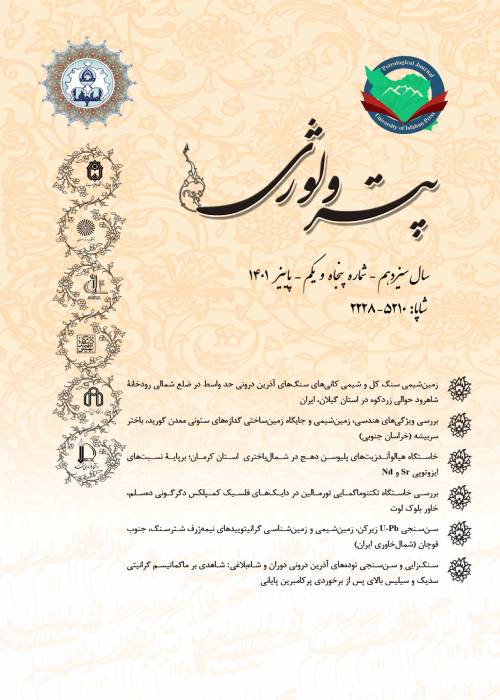Mineralogy and geochemistry of hydrothermal alteration zones underlying the Sargaz Volcanic–Hosted Massive Sulfide Deposit, SE of Kerman
The Sargaz Cu–Zn volcanogenic massive sulfide deposit, in the southern Sanandaj–Sirjan Zone, composed of felsic and mafic volcanoclastic, volcanic rocks, with sandstone, limestone and calcareous tuff and NW-SE trending. The basaltic host rocks with mostly tholeiitic to transitional affinity host the massive sulfide mineralization. The alteration zones related to mineralization system representing the channels of ascending hydrothermal solutions existing within a footwall alteration pipe, with a central siliceous and quartz–sericite core giving rise to zones of quartz–chlorite, chlorite–quartz, and finally chlorite–sericite (stringer envelope zone) on the margins. Pervasive alteration started with the development of chlorite–sericite subsequently overprinted by chlorite, sericite, and finally quartz as hydrothermal activity intensified in the center of the alteration zone. Despite intense alteration of the volcanic rocks, immobile elements (i.e. Ti, Zr) have remained essentially immobile, which allows identification of the precursors and calculation of mass changes. Mass changes calculated for mafic footwall rocks indicating most of the volcanic rocks in the mine area are strongly depleted in Na2O and CaO, and highly enriched in MgO, Si2O and K2O. The Si content is the largest within 5–10 m of the massive sulfide lenses. Intensely silicified footwall basaltic rocks underlie the massive sulfide lens in Sargaz deposit were characterized by white to grey, microcrystalline silica. Mass change analysis of altered footwall basaltic rocks immediately below the massive sulphide zone shows the SiO2 content increases to about 90%. The chloritic and chlorite–sericite alteration zones were enriched in Fe, Mg, with only small amount of K in the chlorite–sericite zone but depleted in Na and Ca most likely due to the alteration of clinopyroxene, plagioclase, and volcanic glass. The change from chloritization to silicification and sericitization must be accompanied by a reduction in pH during silicification and sericitization. Identification of such alteration patterns can be used as an exploration key in other massive sulfide mineral exploration.
- حق عضویت دریافتی صرف حمایت از نشریات عضو و نگهداری، تکمیل و توسعه مگیران میشود.
- پرداخت حق اشتراک و دانلود مقالات اجازه بازنشر آن در سایر رسانههای چاپی و دیجیتال را به کاربر نمیدهد.


